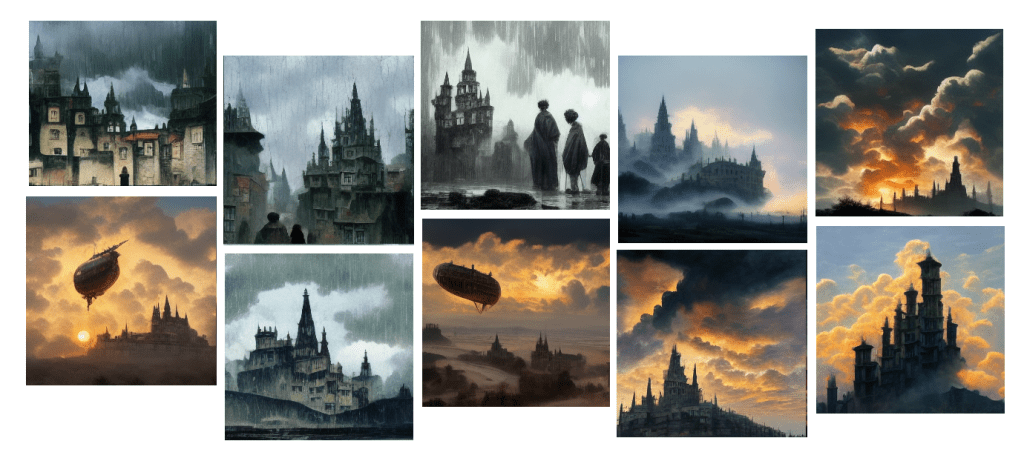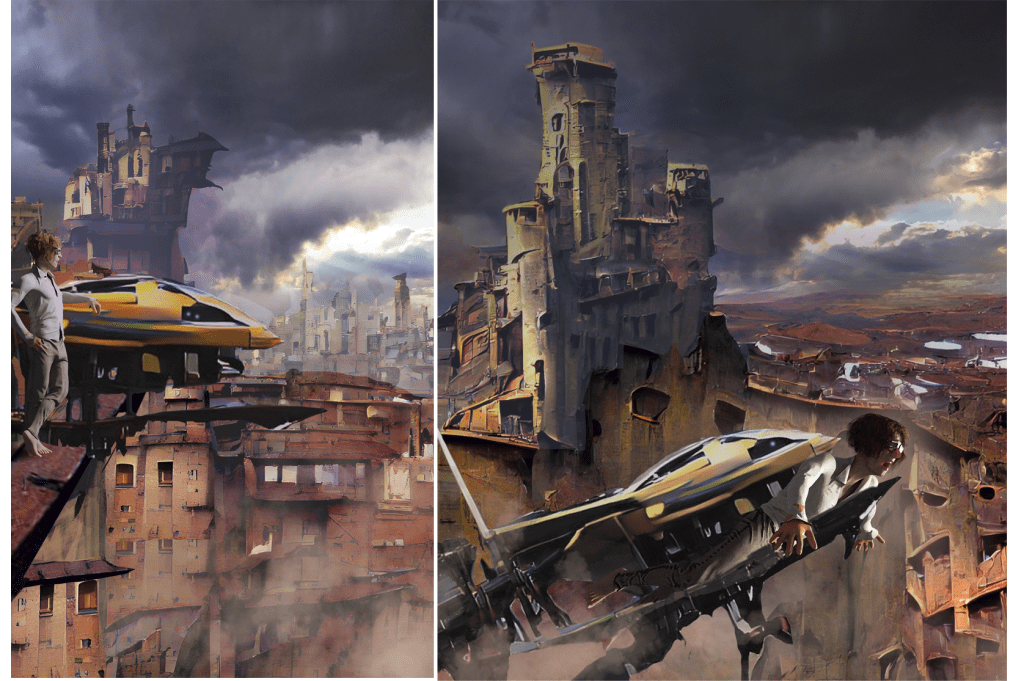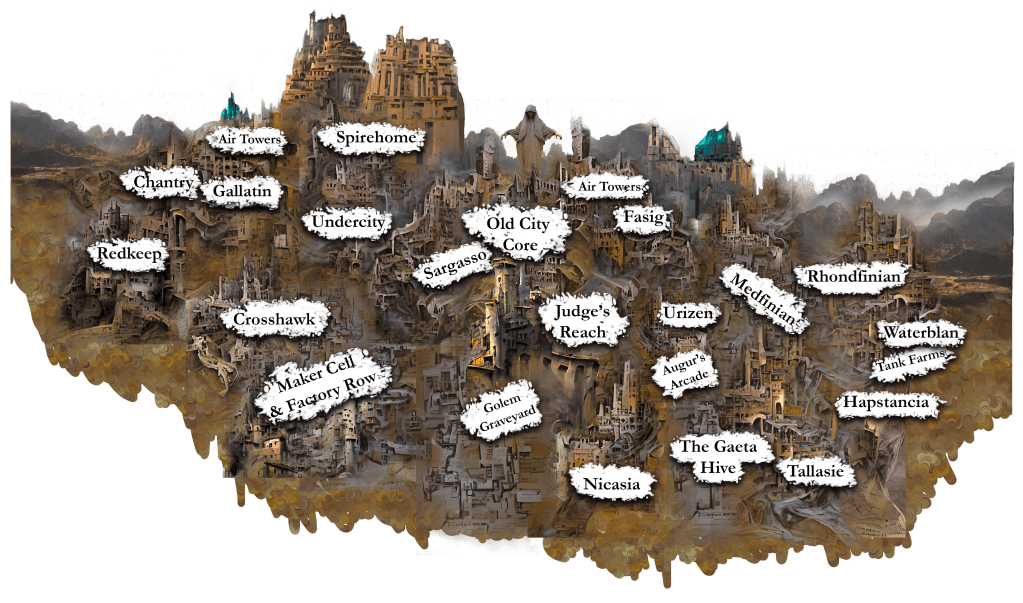
In my day job, I study and coach the imaginative process. In that case, it’s people in factories trying to solve tricky problems that have them stuck, in some cases for many years. Many times, the reason they’re stuck is because of how they’re thinking about the problem. That isn’t my point today; I’m just letting you know that I think a lot about super-charging imaginations – what makes our creativity go off-road and jump out of ruts and tropes into new lands. It’s pretty fascinating, actually.
Take, for example, the massive city-state called The Jagganatheum:
A single edifice sprawling as large as a city, teeming with millions, and buzzing with the incandescent dreams of building an infinite republic. One building spanning as far as anyone could see, strapped to a mountain. It was gorgeous then in the heyday of Naraia, gleaming white and gold with banners flying from soaring towers. And they had to come together in a way never before imagined just to build such a complex, which was entirely the point. Once it fell out of use hundreds of years later, all manner of unrooted and shiftless people moved in and shabbily built upon its framework. Entire towns have grown up inside its rambling and incoherent architecture now. It’s a dangerous place of wild people and best left to them.

Let me tell you what that’s about and take you there. It really gets to the heart of how imaginations work and how they can change our lives.
If you’re new to Grailrunner, our thing here is inspiration, specifically using science fiction and fantasy novels and tabletop games to explore immersive storytelling. Our signature IP is a world setting and sandbox called Salt Mystic. You can find more here. We’re building out the next volume of characters and locations, and I’m working feverishly on a novel to accompany a major development in the tabletop game.
To begin, all I had in this case was a name (The Jagganatheum) and the vague idea of a giant city sprawling across a mountainside that was cobbled together. In fact, the city was just one enormous, hideous building, ages old, and so patched together and crumbling. The name came from the original form of ‘juggernaut’, extended from referring to Vishnu to include gigantic carts pulled in worship through the streets. It meant ‘big’ to me, so I liked it for the purpose. I always loved the image my dad used to describe of himself growing up in Brooklyn, NY in the 1950’s where he’d shimmy up to the rooftop of his school and stare at the sky, dreaming. I was going to steal that too.
That’s where this guy came from:

Envisioning this big, sprawling, wild place and this nameless dreamer growing up in it, I had to ask why he was such a dreamer looking at the sky? What did he hope to find there? Why did he want to leave? This guy, eventually Lamberghast Mazewater, came of those questions and will ultimately be a war marshal in the service of both The Jagganatheum and beautiful Vimana Station (if he survives these crazy vortex glider experiments!).
All this leads me to the first finding about exploring imagined lands, and we’ll let an old inventor introduce it:
“To invent, you need a good imagination and a pile of junk.” -Thomas Edison
Finding #1: Gather inspirations and ask questions about them
By just following the questions and the possibilities, without worrying over plot or key events I needed for the story, and especially without considering ‘sizzle reels‘, the notebook started filling up with great locations inside the city that I’d like to visit and both mighty and intimate things that had happened there. My point with this is that I’ve found it so much more enjoyable to just garden these imaginary settings, to let them breathe and grow wild before I have to prune for the tale I’m telling. I wanted these Jagganatheum streets and alleys to be there, for real, waiting on whoever I was to send scampering into them.
How about we let a fantasy novelist and screenwriter introduce this one, as he compares this sort of writing to gardening:
“They don’t know how many branches it’s going to have, they find out as it grows.” -George R. R. Martin
Finding #2: Avoid using plot points as mileposts
A few months ago, I caught a terrible head cold and fell asleep with a fever after spending time sketching out this place. I’ll never forget the dream that came about that night. It was incredible. I saw the high ceilings of a train station (looking a lot like Milan’s Central Station) with a mishmash of sculptures and friezes, with all manner of exotic people buzzing about. I saw a red armored ceremonial guard, with intricate filigree on their shoulder boards and chest plates. I was taking this train inside The Jagganatheum’s central complex to its far reaches, which echoed a developing plot point that was still (at the time) only just coming into view.
When I woke up, I rushed to write it all down, because I hadn’t thought of them using trains to get around the city. I hadn’t thought of any sort of guards, and didn’t know at the time what they’d be guarding. And being so focused on the exterior views of this mighty, mad place, I hadn’t considered at all what the interiors would look like. Of course, they’d have old statues and dented inscriptions going back to the city’s founding! It made sense; I just hadn’t gotten there.
Which means it’s time again for one of the most quoted, quotable quotes we go to on this site:
“Chance favors the prepared mind.” -Louis Pasteur
Finding #3: Set your mind thinking about the land you wish to explore and build, then do something else. Even sleep.
In my case, it was fortunate to have such an unsettled mind from the fever, but I often use this trick going kayaking or running. I’ll use it before a long plane trip. Just a framing of the problem, its borders and boundaries, then let the engines run behind the scenes.
What’s come of all this is a fully realized and fascinating city that has started to feel like a place I can travel to. It’s mapped out in broad strokes, but the specifics are waiting for me to visit as the needs arise. I swear, when I sit to write on this book, I’m anxious to get Lamberghast moving just so I can see more of this fascinating place.

That’s what I wanted to offer you today, just a few findings from the field as this book and game volume come together. I hope in some small way, I’ve struck a spark with you. We’ll keep you posted as this wonderful thing builds itself!
Till next time,



